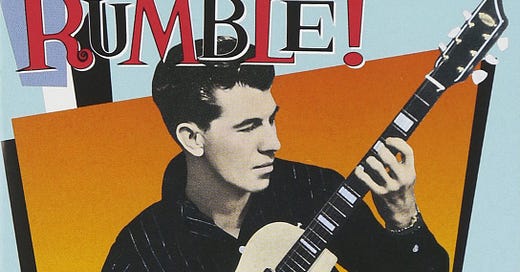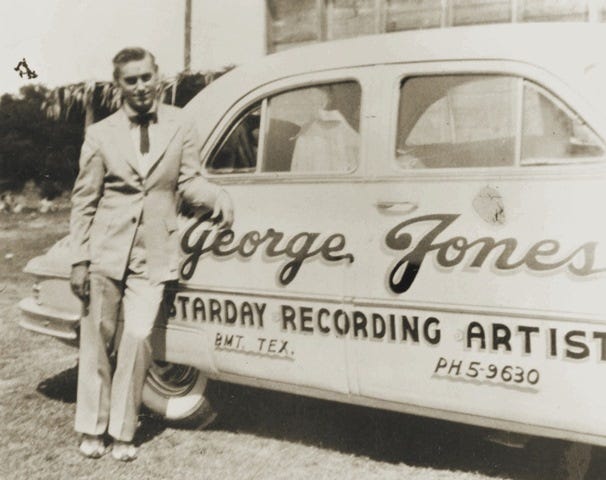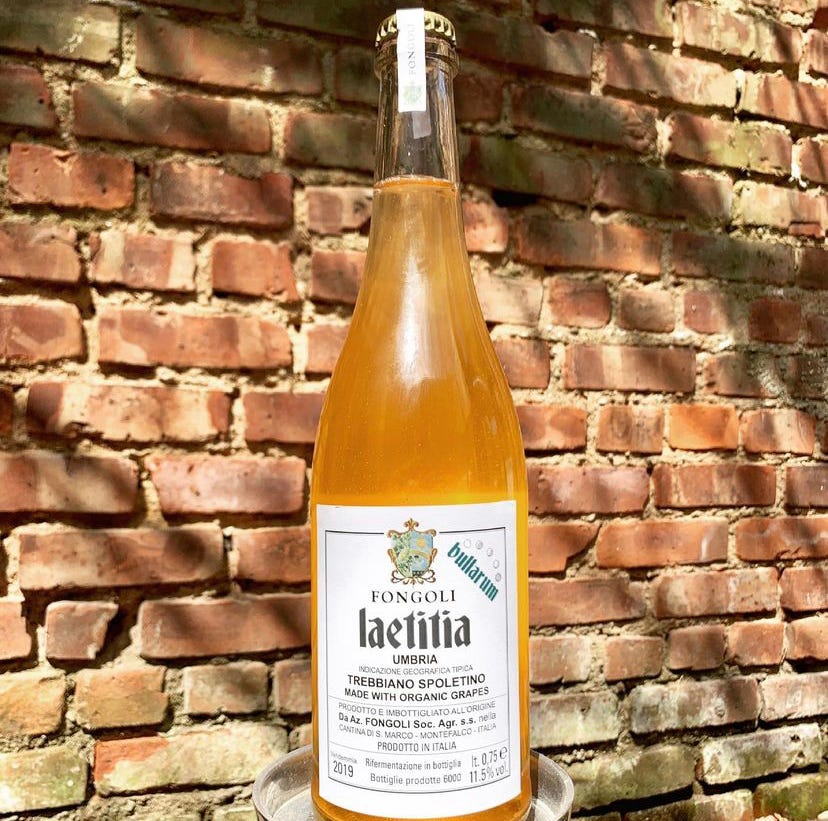It was the D Chord heard around the world. Snarling, guttural — the opening of the 1958 instrumental “Rumble” instantly expanded the guitar’s vocabulary. The half Shawnee son of husband-and-wife backwoods preachers had introduced the power chord, playing both the guitar and its amplifier. A teenaged Paul McCartney had the “Rumble” 45 taped to his record player. Pete Townshend said he wouldn’t have ever picked up the guitar if he hadn’t heard the record. It’s from the power chord and its capacity for menace that we get both heavy metal and punk rock. “Rumble” — an instrumental — was banned in some radio markets. As he was creating the song, Link Wray’s hope was that people would dance to it.
Link Wray was born in Dunn, North Carolina, where they hid that his mother was Shawnee from the KKK and he and his brothers played music at their parents’ brush arbor revivals. Link picked up his older brother Vernon’s guitar at age seven and learned to play gospel and love the blues. In 1944, when Link was maybe 15, the Wrays moved to Portsmouth, Virginia, where the father’s job at the naval yards meant that the family had electricity, shoes, and regular meals. There, Link formed a western swing band with Vernon and younger brother Doug, Lucky Wray and the Palomino Ranch Hands, and played rodeos and joints with sawdust floors up and down the Eastern Seaboard. They were covering country songs, but Link’s guitar was closer to the blues he grew up on; he studied Chet Atkins and Grady Martin, but his playing ran to Leadbelly and Elmore James. If that sounds like early rock ‘n’ roll, it was, even if the Wray brothers’ seemingly parallel invention of it was known only to them.
Wray’s music career was interrupted by the Army and the Korean War, where he contracted tuberculosis, which hospitalized him for a year and cost him a lung. He reunited with his brothers in Washington DC, playing dances and backing Vernon (as Ray Vernon) on a single for the Texas country label Starday, which had recently signed a singing ex-Marine named George Jones.
In 1957, the Wrays were working a DJ record hop for a local Dick Clark-type named Milt Grant when the host suggested they do a song for a dance the kids were doing, The Stroll. Canadian vocal quartet The Diamonds were Gray’s guests that day. They’d had a big hit earlier in ‘57 with “Little Darlin’,” and would have a hit later in the year with “The Stroll,” but hadn’t yet recorded it. Recollections differ, so it isn’t clear if the Wrays backed The Diamonds’ performance of the song or if the Canadians were even still in the building, but what is known is that based on a verbal description of “The Stroll,” Link Wray cranked his ‘53 Les Paul through a shaky Premiere amplifier and played three droning, distorted chords for an on-the-spot song he called “Oddball.” Vernon caught what was happening and shoved his vocal mic in front of the amp to rattle the windows of the Fredericksburg, VA Armory. The kids danced and demanded the song and its floor-shaking sound four more times over the course of the evening.
Dancing The Stroll goes like this: Boys line up on one side and girls on the other; two by two, they meet in the middle to dance together as they move down the line. It’s somewhere between rock ‘n’ roll and a Jane Austen country dance, but it’s from this that we get “Rumble,” which is what “Oddball” became. Grant hustled Wray into a studio, where Link used a pencil to poke holes in the amplifier’s cone to replicate the live distortion. The tape made it to Cadence Records’ Archie Bleyer, who’d been a popular bandleader for the squaresville Arthur Godfrey's Talent Scouts TV show. Bleyer hated the song, but his stepdaughter and her boyfriend, Phil Everly, loved it; one of the young lovers (it’s unclear which) suggested renaming it “Rumble” as its rough sound reminded them of a gang fight.

“Rumble” is a slowburn that never quite ignites, and therein lies its power. It rocks harder than maybe anything before it but couldn’t be bothered to pick up the pace — less like gangs fighting than being stalked by one. Link Wray’s guitar growls out droning chords that are eventually so soaked in tremolo, it sounds under water. His piercing leads descend like a movie villain sauntering down a staircase. Halfway through, he suddenly rakes his pick across the strings in furious strumming; it’s barely musical, just an outburst of anger. Wray didn’t invent power chords or guitar distortion; he popularized a way for them to express rage and frustration. This, along with its juvenile delinquency-inspired title, is what got the song banned. It sold four million copies anyway.
Pete Townshend may have one day picked up a guitar without having heard “Rumble,” but he also might not have the tinnitus to go with it. The Wrays’ other gift to future guitar heroes was when Vernon put the mic to Link’s amp — volume. Volume, as anyone with persistent ringing in the ears knows, creates texture. You don’t just hear it; you feel it. That kind of house PA volume had always been for the singers. Scotty Moore, with his playing on “Jailhouse Rock,” has likewise been credited with inventing the power chord, but he didn’t mic his amplifier because it was Elvis the people wanted to hear. Link Wray’s volume, and anger, made the guitar more than an instrument. He made it the star.
28 Song Playlist
Rock ‘n’ Roll Instrumentals, from Link Wray to Surf Rock
My Sweet Lord, This Is Amazing
The “2021 Remaster” recuts the video of the 2004 Rock ‘n’ Roll Hall of Fame performance of “While My Guitar Gently Weeps” so that once the spotlight is on Prince, it never leaves him. You see all god-level musicianship and his every sly I’m-still-going smile. Astounding and wonderful.
A Natural End to the Summer
A fitting way to mark the end of summer is with a wine that celebrates its growing season. Sip the lightly sparkling Fongoli Laetitia Bullarum Frizzante Trebbiano Spoleto 2019, and you taste what happened in Umbria two summers ago and nothing else.
At Fongoli, where all winemaking follows the phases of the moon, Trebbiano grapes were handpicked and then left to ferment in an open tank however nature saw fit. The juice was then pressed into a stainless steel tank, where it rested on its lees, those little spent yeast deposits that add complexity and a creamy mouthfeel, as well as bit of a cloudy appearance, before being bottled young. The result is Laetitia, a fresh, spritzy wine bubbling with what the end of the season can bring.
Have a good, safe Labor Day Weekend everybody,
Scott







Never tires, that swampy percussion, kills me every time.